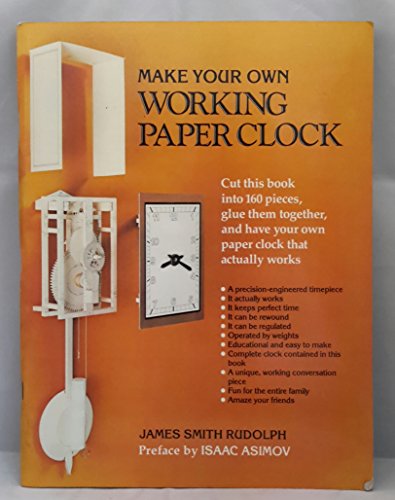Items related to Make Your Own Working Paper Clock

"synopsis" may belong to another edition of this title.
- PublisherHarperCollins
- Publication date2001
- ISBN 10 0060910666
- ISBN 13 9780060910662
- BindingPaperback
- Number of pages40
- Rating
Top Search Results from the AbeBooks Marketplace
Make Your Own Working Paper Clock by James Smith Rudolph [Paperback ]
Book Description Soft Cover. Condition: new. Seller Inventory # 9780060910662
Make Your Own Working Paper Clock
Book Description Condition: New. Seller Inventory # 499245-n
Make Your Own Working Paper Clock
Book Description Paperback. Condition: New. Seller Inventory # BKZN9780060910662
Make Your Own Working Paper Clock Format: Paperback
Book Description Condition: New. Brand New. Seller Inventory # 0060910666
Make Your Own Working Paper Clock
Book Description Large Paperback. Condition: New. New condition-You cut this book into 160 pieces, glue them together and have your own clock that works-complete paper parts in book-Preface by Isaac Asimov=instructions included. Seller Inventory # 005211
Make Your Own Working Paper Clock (Paperback)
Book Description Paperback. Condition: new. Paperback. Clocks by Isaac Asimov Through most of history, people hardly felt the need of clocks. It seemed sufficient to consult one's own physiology to tell when one was hungry or sleepy, or to observe the general position of the sun in the sky during the day or that of the Big Dipper at night. Those who were meticulous enough to want something better searched for some regular motion that existed in nature or that could be contrived. In ancient times, the sundial was invented so that the passage of the shadow of a rod could be followed as the sun crossed the sky. Or else one could observe the extent to which a candle burned downward, or wait till a certain amount of sand had sifted through a small opening. Such devices could be used on cloudy days or at night, when the sun could not be seen and shadows were not observed. In ancient times, the best timepiece was the clepsydra, or water clock, which measured time by the regular dripping of water through a narrow opening. As water accumulated in the lower reservoir, a float carrying a pointer rose and marked the hours. The best water clocks were quite elaborate but few in number and fragile. They could not be relied on to tell time more closely than a fairly large fraction of an hour. In medieval Europe, the mechanical clock was invented. Clever arrangements of gears and wheels were devised that could be made to turn by weights attached to them. As the weights were pulled downward by the force of gravity, the wheels were forced to turn in a slow, regular manner. A pointer, properly attached to the wheels, marked the hours. These mechanical clocks were less delicate than water clocks and required less maintenance. They became commonin churches and monasteries and could be relied on to tell when to toll the bells for regular prayers or church attendance. (The very word "clock" is from the French cloche, meaning "bell.") Eventually, mechanical clocks were designed to strike the hour and even to chime the quarter-hour. However, they had only an hour hand and were not enclosed. Even the best such clocks would gain or lose up to half an hour a day. No clock in existence, up through 1656, could measure short intervals of time accurately, or could possibly be relied on to tell time to the minute. This meant that advances in physical science were scarcely possible. Almost all of physics and much of chemistry (and even biology) depend on rates, on the rapidity with which processes take place, on the amount of change that takes place per unit of time. In order to measure such rates with the precision required for the development of the laws of nature, intervals of time must be marked off with far greater exactness than was possible for the crude clocks of ancient and medieval times. In the 1590s, for instance, the Italian scientist Galileo measured the speed of falling bodies. This was the crucial beginning of modern physics and, therefore, of modern science. His experiments disproved the physics of Aristotle that had held sway for eighteen centuries and laid the foundation for Isaac Newton's later laws of motion and theory of universal gravitation, on which (allowing for Einstein's improvements, and for the addition of electromagnetism and the two nuclear forces) science is still based. Yet Galileo had no device for measuring the time it took for balls to slide down the groove of an inclined plane. it took them anumber of seconds to do so, and there existed no clock that could mark off seconds. He had to stand there taking his own pulse and counting his heartbeats as the balls moved downward. That sufficed for the purpose-but just barely. It made his conclusions little more than an intelligent approximation. To go further, more was needed. Yet in 1582, Galileo (then a teenager) had noticed the swaying chandeliers in a cathedral. it seemed to hi Shipping may be from multiple locations in the US or from the UK, depending on stock availability. Seller Inventory # 9780060910662
Make Your Own Working Paper Clock
Book Description Paperback. Condition: New. Seller Inventory # DADAX0060910666
Make Your Own Working Paper Clock
Book Description Condition: New. . Seller Inventory # 52GZZZ00X9DD_ns
Make Your Own Working Paper Clock
Book Description PAP. Condition: New. New Book. Shipped from UK. Established seller since 2000. Seller Inventory # WB-9780060910662
Make Your Own Working Paper Clock
Book Description Paperback. Condition: new. New. Fast Shipping and good customer service. Seller Inventory # Holz_New_0060910666

